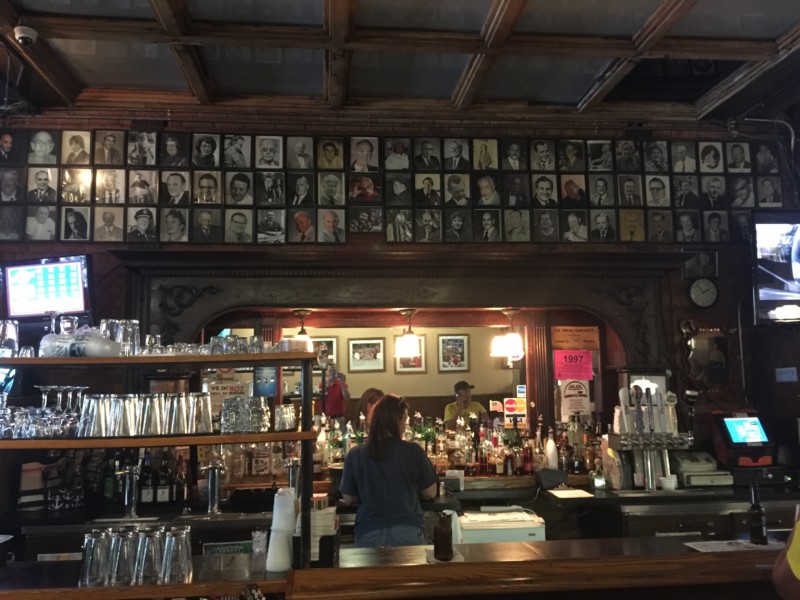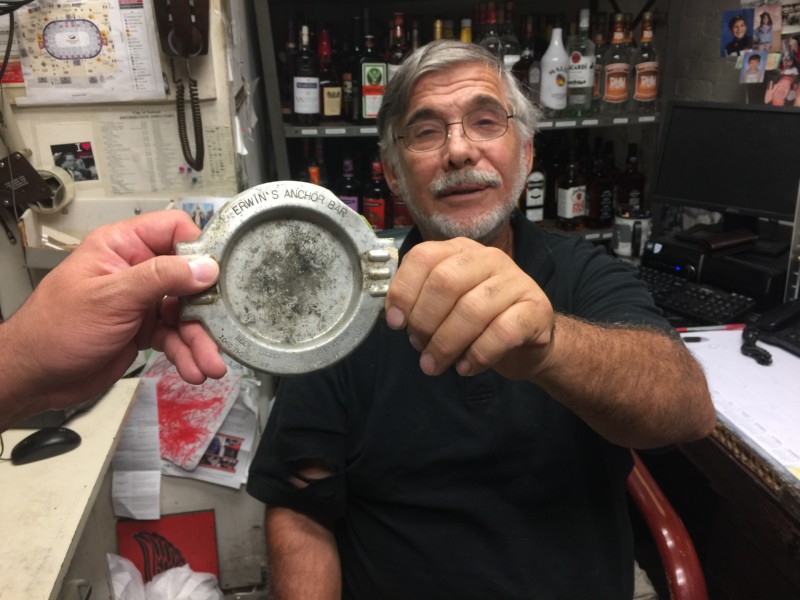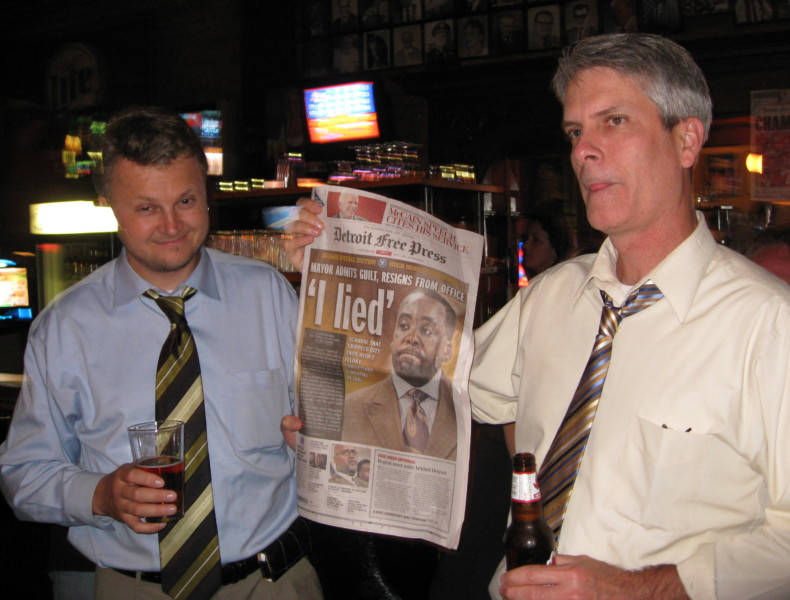One of my first journalistic ambitions was to get my photo on the wall behind the bar at the Anchor. Then I realized that everyone pictured above the bar was dead.
Among the striking features at Anchor Bar—a family-run Detroit institution for nearly six decades and perhaps the last great journalism bar in America—is a grid of portraits that spans the wall above the bar itself. One photo shows a cop; another, a reputed debt collector for local mob families. There’s a monsignor in horn-rimmed glasses who grins, impish, and pinches a cigarette between his fingers while he offers a sort of salute.
From the archives: A toast to undercover journalism’s greatest coup, when reporters bought a bar
The majority of the customers pictured above the bar—men, mostly, but a few women, too—are journalists. Bob Wood, the first Anchor patron to have his portrait displayed, was a copy editor at the Detroit News. The Derderians, the family that has run the Anchor for nearly 60 years, considered Wood a “key wheel”—a term, borrowed from the horse-racing world, to refer to those patrons whose charisma attracted more customers.

Portraits above the bar at the Anchor. Image via M.L. Elrick.
Like generations of journalists before me, I went to the Anchor at lunch, after work, and on weekends. Like those reporters who eventually took jobs out of town, I often dropped in whenever I returned to Detroit, looking to connect with my fellow ink-stained wretches. In late July, when Deadline Detroit reported that the Derderians would relinquish control of the Anchor, I realized that I’d been a regular for nearly half the bar’s lifetime—and more than half of my own 50 years.
On my first visit to the Anchor, the array of union officials and police, papists and arm-benders, Wood and his ilk had encouraged me. “Someday,” I told myself, “I’m going to get my picture up there.”
I WAS AN INTERN at the Detroit Free Press when I first stepped foot in the Anchor on a night in 1990. At the time, the bar was the only going concern in the otherwise vacant Fort Shelby Hotel. Located between the warring Free Press and News, and across from Detroit’s NBC affiliate, the Anchor was the imbibing journalist’s equivalent of Flanders Fields, where (according to the apocryphal story) British and German troops played soccer on Christmas Eve in 1914. Editors, photographers, clerks, copy aides, and anchor men convened after deadline or before the 11 o’clock news and drank together.
On those afternoons when I’d finished my work and my editors couldn’t be bothered with the punk kid with baggy pants, earring, and skinny tie, I’d sneak down Lafayette Boulevard. At the Anchor, I’d have a couple tall whiskey-and-Cokes and bump and grind my way through a few quarters on Whirlwind, the pinball machine near the dart boards and the pool table. Within a few hours, some of the interns would gather and make plans for the evening. Superstar sports intern Jennifer Frey would order Sea Breezes, and I’d play “A Big Hunk O’ Love” by Elvis Presley on the jukebox and sink a couple more drinks.
The drinks were cheap, sure, but we also felt like we were a part of a rich tradition. Newspaper memorabilia—including images printed and hand-delivered by the photographers who shot them—covered the veneer-lined walls.
Leo Derderian, the godfather of the Anchor, occasionally drifted through the bar. In 1959, he gave up a grocery store that functioned as a front for a bookmaking operation and bought a liquor license from Erwin “Izzy” Ezrach. (The Derderian family still has a brazenly sexist aluminum ashtray promoting “Erwin’s Anchor Bar” and depicts a buxom woman atop a keg of beer. “Women wouldn’t be caught dead there,” Leo’s son Vaughn tells me. “The only women who would go in there were journalists.”) The feds eventually raided that first Anchor location for—surprise—bookmaking. Customers provided Vaughn with photos of the raid, plucked straight from the local news archives.

Vaughn Derderian holds up an ashtray preserved from “Erwin’s Anchor Bar.” Image via M.L. Elrick.
There have been a few incarnations of the bar, all downtown and within blocks of its current location. In 1973, a storm forced the closure of the building that housed the Anchor. It reopened two years later in the Hotel Fort Shelby, where it remained until 1993. A proposed rent hike convinced Vaughn to buy the nearby Mercier Building, a handsome two-story fortress so sturdy it had once been a fallout shelter—an apt designation for a place where journalists frequently got bombed.
Leo Derderian died in 1994. Not long after, the last major newspaper labor dispute in America turned the Anchor into a sanctuary for displaced journalists. The Free Press and News, in a bid to save themselves, had used the Newspaper Preservation Act, which authorized joint operating agreements, to merge business operations. By the time the Anchor moved into its current digs, however, the Newspaper Preservation Act looked more like a suicide pact. After the News imposed merit pay, union workers at the News and the Free Press walked out. The Anchor provided a place for strikers to commiserate downstairs and strategize upstairs, where Vaughn provided a rent-free headquarters for the council of unions. The weekly strike paper, the Sunday Journal, would later relocate to the Anchor. The honored dead witnessed it all from their framed perches above the bar.
A friend from stopped at the Anchor to kill a few hours during a brief layover. He called from the bar and told me he was looking at my picture on the wall. Before he could explain, I checked to make sure I was still alive.
DESPITE THE MANY going-away parties, Friday evening gargles, and other moments magnificent and mundane, I feel inadequate to catalog the Anchor’s rich history. The Anchor’s institutional memory mostly belongs to Vaughn Derderian, Leo’s son, who graduated from Oakland University with a degree in political science and who has worked at the Anchor for most of his life. Even Vaughn acknowledges that many moments are lost to the haze of time and booze.
Squeezed into the Anchor office, next to the big safe and across from shelves lined with liquor bottles, Vaughn attributed the bar’s success to the bygone patrons whose portraits line the bar.
“I like to say, ‘If those people were alive, I wouldn’t need any of you fuckers!’” Vaughn told me.
In all likelihood, the Anchor has relied far more on thirsty Red Wings fans to pay its bills during the past 20 years. Still, the Derderians have a soft spot for truth-tellers. When I asked Vaughn to tick off some of the Anchor’s highlights, he mentioned the fall of Detroit Mayor Kwame Kilpatrick—a story I reported with Free Press colleagues that won the Pulitzer Prize for Local Reporting in 2009.
For that story, Jim Schaefer and I used text messages from Kilpatrick’s chief of staff and lover to reveal that Kilpatrick lied under oath during a whistleblower trial about their affair and their efforts to silence two cops they believed knew too much about their illicit activities. Kilpatrick’s mendacity cost taxpayers more than $8 million. On the night Kilpatrick pleaded guilty to obstruction of justice and perjury charges and agreed to resign from office, we gathered at the Anchor, as we had on so many big news nights, to mark the occasion with a beer or four. That night, Charlie LeDuff—a Detroit News journalist at the time—shouted at a belligerent Kilpatrick sympathizer at the bar, “We did that—those were our stories!” When the Free Press won the Pulitzer, we celebrated with family and friends at the Anchor.
I learned a few years later that, in a way, Kilpatrick’s fall helped me realize my ambition from my intern days. A friend from The Washington Post had stopped at the Anchor to kill a few hours during a brief layover. He called from the bar and told me he was looking at my picture on the wall. Before he could explain, I checked to make sure I was still alive. Turns out the Derderians had posted a photo of Schaefer and me, beers in hand, holding up a first edition with Kilpatrick’s admission, “I LIED,” in massive type.
It wasn’t exactly the wall of honor. But, for now, it’s close enough.

The author (left) and Jim Schaefer stand with their September 5, 2008, front-page coverage of then-mayor Kwame Kilpatrick’s resignation, part of a series of stories that won the Detroit Free Press a Pulitzer Prize in Local Reporting. Photo by Steve Dorsey.
From the archives: Why the media don’t get Detroit—and why it matters
M.L. Elrick is a recipient of numerous state and national journalism awards, including the 2009 Pulitzer Prize in Local Reporting. He lives in Detroit.

